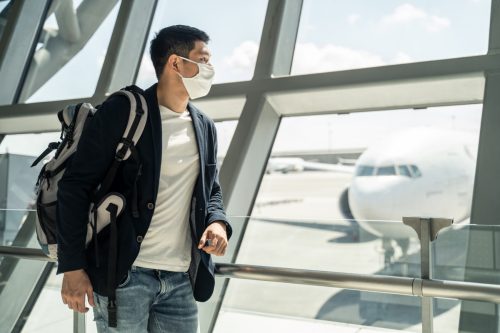What’s Really Behind China’s Surge in Respiratory Illnesses, Doctors Say

In 2020, our lives changed in a way none of us saw coming. As COVID spread across the globe, we faced unprecedented sickness, along with lockdowns and mass closures. Since then we’ve been on high alert, which is why news of a surge of respiratory illnesses in China—where COVID was first detected—has many people concerned about the potential for another deadly pandemic. Now, doctors are weighing in with their insight on this new outbreak, and trying to put at least some of our concerns to rest. Read on to find out more about the illnesses spreading in China, and what that means for the rest of the world.
RELATED: Doctor Reveals COVID Symptoms in Patients Who Haven’t Gotten a Fall Booster.
China is experiencing a surge in respiratory illnesses right now.

Last week, there were multiple reports about hospitals in Beijing and northern China struggling with a surge of respiratory illnesses, primarily affecting children. According to CNN, hundreds of patients are lining up and waiting for hours at children’s hospitals in major cities across northern China.
On Nov. 21, an official at Beijing Children’s Hospital told state media that they are currently experiencing an average of more than 7,000 patients a day, which “far exceeds the hospital’s capacity.” Meanwhile, the largest pediatric hospital in the city of Tianjin broke a record on Nov. 18 with more than 13,000 children coming to its outpatient and emergency departments.
“Right now, we have a lot of kids here,” a staff member at the Beijing Friendship Hospital told CNN on Nov. 23. “Those who booked an emergency appointment yesterday still weren’t able to see the doctor this morning.”
RELATED: New “Highly Contagious” Skin Infection Is Spreading, CDC Warns—How to Stay Safe.
Doctors say that this “does raise concern.”

Reports about the current situation in China share some eerie similarities to headlines seen at the start of 2020, before COVID became a worldwide concern, Yahoo Life reported. Doctors acknowledge that the idea of a “mystery” surge in respiratory illness does inspire some anxiety.
“What’s going on in China does raise concern,” Ian Michelow, MD, division head of pediatric infectious diseases and immunology at Connecticut Children’s Specialty Group, told Yahoo Life. “Influenza and the original SARS also did arise in China. It’s always good to be aware of outbreaks there so we can be prepared.”
Richard Watkins, MD, an infectious disease physician and a professor of internal medicine at the Northeast Ohio Medical University, shared a similar perspective with the news outlet.
“Any health information from China should be verified given what happened with COVID-19 and the fact that we still do not have a clear understanding of the origin of SARS-CoV-2 [the virus that causes COVID-19],” he told Yahoo Life.
RELATED: The Most Accurate Time to Take a COVID Test, New Study Reveals.
But the uptick doesn’t seem to be coming from a new virus.

On Nov. 22, the World Health Organization (WHO) “made an official request to China” to get more detailed information on the country’s recent increase in respiratory illnesses. In a follow-up report the next day, WHO revealed that Chinese authorities have attributed the new surge to the cold season and known pathogens that typically circulate more during this time, such as influenza, Mycoplasma pneumoniae, respiratory syncytial virus (RSV), and COVID.
Officials said that China’s recent relaxation of COVID-based restrictions are also likely playing a part in the surge—something other countries saw earlier when they lifted their own precautions.
“This is exactly what happened one year ago in the U.S. and other countries when children, who were fully socially interacting, became infected with pathogens that they had avoided during COVID-19 social distancing,” Amesh A. Adalja, MD, a senior scholar at the Johns Hopkins Center for Health Security, told Yahoo Life.
Michelow said that it is “not surprising” that China is experiencing this surge now because the country is “lagging by a year” due to lockdowns that extended until after last winter, according to the news outlet.
“Because of lockdowns, children weren’t exposed to these illnesses when they ordinarily would have built up immunity to these infections,” he said. “Nature has made us pay a price for that.”
WHO has advised certain measures to help keep people safe.

WHO said that while some of the increases in respiratory illnesses are “earlier in the season” than what China has experienced historically, it is not “unexpected given the lifting of COVID-19 restrictions, as similarly experienced in other countries.” The organization also indicated that Chinese health authorities have “advised that there has been no detection of any unusual or novel pathogens or unusual clinical presentations” associated with this surge.
But new pathogens or not, it’s still important for people to stay safe. Currently, WHO said it is not recommending any specific measures for travelers to China. But “in general, persons should avoid travel while experiencing symptoms suggestive of respiratory illness, if possible,” the organization said. “And in case of symptoms during or after travel, travelers are encouraged to seek medical attention and share travel history with their health care provider.”
WHO also recommended that people in China follow certain measures to reduce the risk of respiratory illness—which is something those in the U.S. can do as well during cold and flu season. These include getting “recommended vaccines against influenza, COVID-19 and other respiratory pathogens as appropriate; keeping distance from people who are ill; staying home when ill; getting tested and medical care as needed; wearing masks as appropriate; ensuring good ventilation; and practicing regular handwashing.”
RELATED: For more up-to-date information, sign up for our daily newsletter.
Best Life offers the most up-to-date information from top experts, new research, and health agencies, but our content is not meant to be a substitute for professional guidance. When it comes to the medication you’re taking or any other health questions you have, always consult your healthcare provider directly.